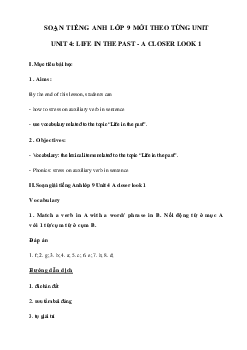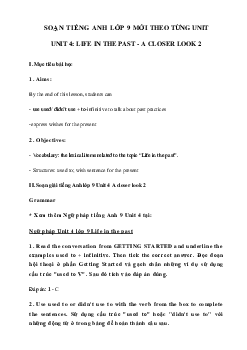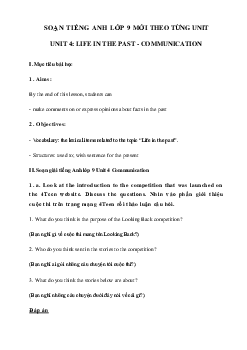



Preview text:
SOẠN TIẾNG ANH LỚP 9 MỚI THEO TỪNG UNIT
UNIT 4: LIFE IN THE PAST - SKILLS 2
I. Mục tiêu bài học 1. Aims:
By the end of this lesson, students can
- listen for specific information about school life in the past
- write a description of how children in the past studied without technology 2. Objectives:
- Vocabulary: the lexical items related to the topic "life in the past”.
II. Soạn giải tiếng Anh lớp 9 Unit 4 Skills 2 Listening
1. An old man is talking about his school days. Listen and decide if the
statements are true (T), false (F), or not given (NG). M ột người đàn
ông lớn tuổi đang kể về ngày tháng đi học của mình. Nghe và xem câu
nào đúng(T), sai( F), hay không có thông tin (NG). Bài nghe Đáp án
1 - F; 2 - T; 3 - T; 4 - NG; 5 - F; 6 - ;
2. Listen again and fill the blanks with the correct information. L ắng
nghe lần nữa và đi ền vào ch ỗ trống với thông tin đúng. Bài nghe Đáp án 1 - 15 2 - bare-footed. 3 - maths. history 4. strict rules 5 - extra classes
Lời giải chi tiết 1. Number of students: 15 .
(Số lượng học sinh: 15.)
2. Some students went to school bare-footed.
(Nhiều học sinh đi học bằng chân trần.)
3. Lessons focused on: reading, writing, and maths, history /(history, maths).
(Các bài học tập trung vào: đọc, viết, toán học, và lịch sử.)
4. The school was small but it had strict rules.
(Trường học nhỏ nhưng có quy định nghiêm ngặt.)
5. The students had no homework or extra classes.
(Các học sinh không có bài tập về nhà, không kiểm tra trên lớp.) Nội dung bài nghe
I went to a village school. In fact, there was only one classroom for 15 students of
different ages, both boys and girls, and one teacher who taught everything. The school
didn't have a name, so we just called t ‘our school’. We used to walk to school. Some children went bare-footed.
At school we learnt to read and to write. We also learnt a little maths and history. There
were no science lessons, and we didn't have exams, either.
Although our school was small, it had strict rules. We had to behave ourselves. We stood
up and bowed to greet our teacher at the start of every lesson. We could talk only when
we were allowed to. However, I've had no homework and no extra classes. I had a lot of
time to play outside and to help my parents in the house. I loved my school and those school days.
(Tôi đi học ở trường học làng. Trên thực tế, chỉ có một lớp học cho 15 học sinh ở các độ
tuổi khác nhau, cả nam lẫn nữ, và một giáo viên đã dạy mọi thứ. Nhà trường không có
tên, vì vậy chúng tôi chỉ gọi là 'trường học của chúng tôi'. Chúng tôi thường đi bộ đến
trường. Nhiều đứa trẻ đi chân trần.
Ở trường, chúng tôi đã học cách đọc và viết. Chúng tôi cũng đã học được một ít toán
học và lịch sử. Không có môn khoa học, và chúng tôi cũng không có các kỳ thi.
Mặc dù trường chúng tôi còn nhỏ nhưng nó có các quy tắc nghiêm ngặt. Chúng tôi đã
phải tư ứng xử. Chúng tôi đứng dậy và cúi chào chào đón giáo viên của chúng tôi vào
đầu mỗi bài học. Chúng ta chỉ có thể nói khi chúng tôi được phép. Tuy nhiên, tôi không
có bài tập ở nhà và không có lớp học thêm. Tôi đã có rất nhiều thời gian để chơi bên
ngoài và để giúp cha mẹ tôi trong nhà. Tôi yêu trường học của tôi và những ngày ở trường). Writing
3. Make a list of the facilities you are using your studies nowadays.
Then tick one(s) you think was/were not avail about twenty years ago.
Lập 1 danh sách cơ s ở vật chất bạn đang sử dụng cho vi ệc học tập.
Tích vào những thứ bạn nghĩ là đã không được sử dụng cách đay 20 năm. Đáp án 1. board 2. project 3. chalk 4. computer 5. desks 6. chair
4. Choose one facility which was not available twenty years ago and write a short
description of how students in the past studied without that facility.
(Chọn một cơ sở vật chất không được sử dụng cách đây 20 năm rồi viết 1 đoạn văn về
chủ đề học sinh ngày xưa làm thế nào để học mà không có cơ sở vật chất đó.)
In your writing, you should include: (Trong bài viết nên có:)
what facility it is (Đó là cái gì?)
what it is used for (Nó được sử dụng vào việc gì?)
how students did the job in the past when they didn't have it (Học sinh phải làm gì nếu không có nó?)
how you feel about the change (Bạn cảm thấy thế nào về sự thay đổi đó?) Gợi ý đáp án
Students didn’t have a chance of studying with projectors twenty years ago. Nowadays,
these devices have been widely used for displaying presentations in classrooms. In the
past, most teacher relied solely on books and blackboards, however the method made
students feel boring and hardly focus on the lessons. Moreover, some pictures, drawings
or objects used for illustration were not big enough for all students to see clearly, which
led them to crowd into a place to see these pictures. Apparently, modern projectors
connected to computers allow teachers to deliver lessons effectively through vivid
presentations and get students more involved in the learning process. To sum up,
projectors is one of the most effective studying devices for both teachers and students.




